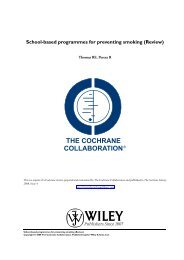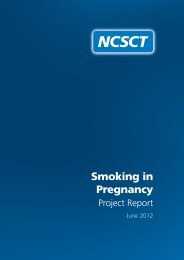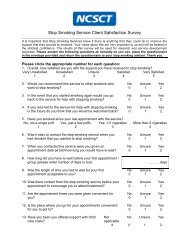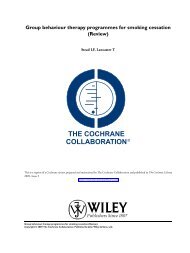Smoking and mental health - NCSCT
Smoking and mental health - NCSCT
Smoking and mental health - NCSCT
Create successful ePaper yourself
Turn your PDF publications into a flip-book with our unique Google optimized e-Paper software.
3<br />
Neurobiological <strong>and</strong> behavioural<br />
mechanisms linking smoking <strong>and</strong> <strong>mental</strong><br />
disorders<br />
Although the prevalence of smoking among people with <strong>mental</strong> disorders is<br />
high, <strong>and</strong> as outlined in Chapter 2 has proved relatively refractory to change, the<br />
mechanisms underlying this association, <strong>and</strong> in particular the direction of<br />
causation between smoking <strong>and</strong> <strong>mental</strong> illness, remain poorly understood. This<br />
chapter reviews some of the biological mechanisms that may be responsible for<br />
the association between smoking <strong>and</strong> <strong>mental</strong> disorders.<br />
3.1 Mechanisms of nicotine addiction<br />
There is widespread agreement that nicotine is the principal addictive<br />
component of tobacco smoke. Behavioural studies with experi<strong>mental</strong> animals<br />
have provided convincing evidence that nicotine has the behavioural properties<br />
of drugs of dependence, because nicotine serves as a reinforcer in selfadministration<br />
studies, 1,2 <strong>and</strong> abrupt withdrawal after a period of continuous<br />
infusion evokes a withdrawal syndrome, which is reversed by the readministration<br />
of nicotine. 3,4 The behavioural changes evoked by nicotine<br />
withdrawal in this paradigm are thought to model important components of the<br />
abstinence syndrome experienced by many smokers when they first quit<br />
smoking. 5,6 Neurobiological studies have also shown that nicotine acts on neural<br />
pathways within the brain that have been implicated in reward <strong>and</strong><br />
reinforcement. In experi<strong>mental</strong> animals, injections of nicotine delivered noncontingently<br />
(ie by an experimenter) or contingently (by self-administration)<br />
stimulate the release of dopamine in both the shell <strong>and</strong> core subdivisions of the<br />
nucleus accumbens. 7–9 Repeated daily administration of the drug results in<br />
sensitisation of its effects on dopamine (DA) overflow in the core subdivision of<br />
the accumbens. 10–12 This effect is independent of contingency. However, repeated<br />
self-administration of nicotine across days also results in sensitisation of its effect<br />
on DA overflow in the shell subdivision of the accumbens. 9 Sensitisation of these<br />
pathways is a property of drugs of dependence of different pharmacological<br />
groups, <strong>and</strong> has been implicated in the transition from simple reinforcement to<br />
the compulsive drug-seeking <strong>and</strong> drug-taking behaviour that characterises<br />
dependence. 13,14<br />
38 © Royal College of Physicians 2013














